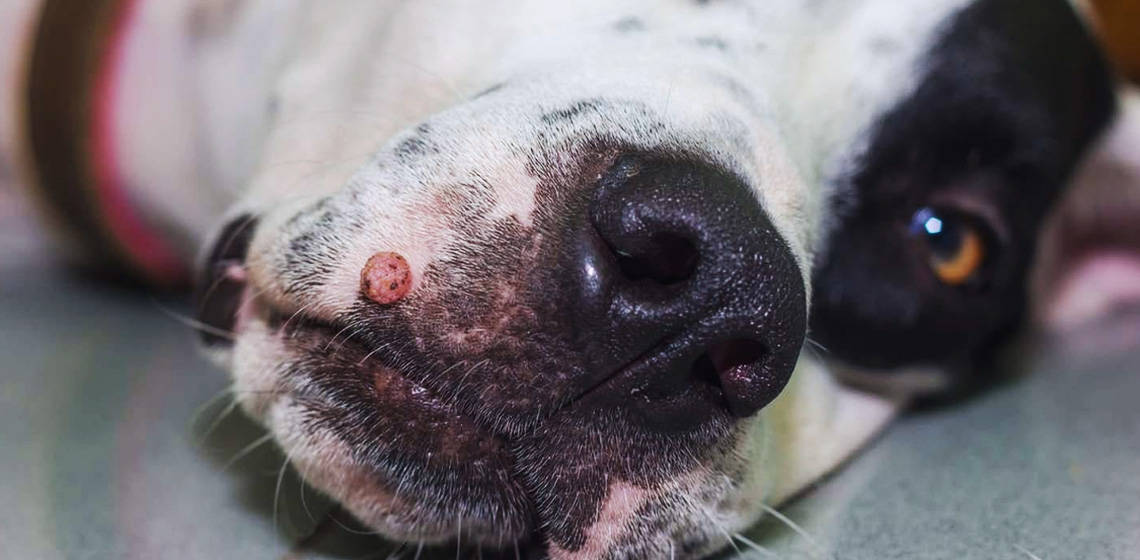Dogs can develop various types of growths on their skin, which can be concerning for pet owners. While some growths are benign and harmless, others can be malignant and require prompt veterinary attention.
According to the Merck Veterinary Manual, tumors affecting the skin or the tissue just under the skin are the most commonly seen tumors in dogs.
You are reading: 10 Types Of Growths On Dogs
In this article, we will discuss 10 types of growths that can occur on dogs, including skin tags, abscesses, hives, lipomas, cysts, warts, histiocytomas, perianal adenomas, mast cell tumors, and melanomas.
It’s important to note that any lump or bump on a dog should be evaluated by a veterinarian to determine the cause and appropriate treatment. Early detection can lead to successful treatment.

10 Types Of Growths On Dogs
Skin tags

Skin tags are benign growths that can appear anywhere on the skin of a dog. They are most frequently noticed on the trunk, the face, the sternum, and in pressure areas such as the chest, knees, and elbows.
Skin tags are usually caused by chronic irritation, and they grow slowly over time. They are more commonly seen in older dogs. Skin tags are generally harmless and do not require treatment unless they become irritated or cause discomfort to the dog.
If a skin tag is causing problems, it can be removed surgically by a veterinarian. It’s important to note that any lump or bump on a dog should be evaluated by a veterinarian to determine the cause and appropriate treatment.
Abscess
An abscess is a pocket of pus that develops when a wound of some sort becomes infected with bacteria. Abscesses can occur almost anywhere within a dog’s body, including the brain, liver, and lungs, but more often, abscesses are fairly superficial, and develop in the animal’s anal glands, at the root of a tooth, or just below the surface of the skin.
Abscesses can have many causes, including bite wounds, scratches, or ingrown hairs. Certain breeds, such as English Bulldogs, Labrador Retrievers, and Chinese Shar-Pei, are at increased risk of developing abscesses.
Symptoms of abscesses in dogs vary depending on the location of the abscess, but may include redness, warmth, pain, swelling, and fever. Treatment for abscesses may involve antibiotics, pain medication, warm compresses, and surgical drainage.
It’s important to seek veterinary attention if your dog develops an abscess, as untreated abscesses can become chronic or even cause life-threatening infections.
Hives
Hives, also known as urticaria, are a skin condition characterized by raised red welts that can appear anywhere on a dog’s body, including the face, lips, tongue, throat, and ears.
Hives are usually caused by an allergic reaction to a substance that the dog has come into contact with, such as insect bites, food, pollens, molds, vaccinations, and medications.
Hives can also be caused by environmental factors such as friction, sunlight, heat, exercise, stress, and genetic abnormalities. Symptoms of hives in dogs include raised wheals, itchiness, swelling, redness, and a patchy-looking coat.
Hives are usually self-limiting and cause no significant health threat to the dog, but in severe cases, they can lead to anaphylaxis, a medical emergency that requires immediate veterinary attention.
Treatment for hives may include antihistamines, corticosteroids, and identifying and eliminating the cause of the allergic reaction.
Lipomas
Lipomas are benign tumors that often develop in dogs, and they are made up of fat cells. They are most commonly seen in middle-aged and senior dogs, and they tend to grow slowly.
Read more : Can Dog Eat Squid?
Lipomas can develop anywhere on a dog’s body, but they are most often found on the abdomen, chest, or legs. There are three types of lipomas seen in dogs: simple fatty tumors, infiltrative lipomas, and liposarcomas.
Simple lipomas are the most common type and develop in the fatty tissue layer found under the dog’s skin. They tend to grow slowly and can be moved without causing any pain or discomfort. Infiltrative lipomas grow in between the dog’s muscle layers and can cause discomfort whenever the dog walks.
Liposarcomas are the malignant form of lipomas, but they are rare in dogs. Lipomas are usually harmless and do not require treatment unless they become large enough to cause discomfort or interfere with mobility. If a lipoma is causing problems, it can be removed surgically by a veterinarian.
Cysts
Cysts are fluid-filled sacs that can develop on or under the skin of dogs. They can look and feel different depending on the type, but they are typically slow-growing, smooth, raised bumps. Cysts can contain secretions that occur naturally in the body, such as keratin or dead cells, or they can be formed by hemorrhage or trauma that leads to tissue death.
Cysts can have many causes, including injuries, pressure points, infections, certain diseases or medications, and idiosyncratic injection reactions. There are many types of cysts that dogs can develop, with the vast majority being benign and non-cancerous.
Some common types of cysts found externally on dogs include true and false cysts, follicular cysts, sebaceous cysts, and dermoid cysts. Treatment for cysts may involve antibiotics, surgical removal, or monitoring for changes.
It’s important to note that any lump or bump on a dog should be evaluated by a veterinarian to determine the cause and appropriate treatment.
Warts

Dog warts, also known as canine papillomas, are small, raised growths that can appear anywhere on a dog’s body, including the lips, eyelids, paws, and inside the mouth and throat. They are caused by infection with papillomaviruses, and each type of virus tends to cause a particular form of the disease.
Warts on dogs often look like a small head of cauliflower, but other, rarer types do exist, including an inverted papilloma and dark, scaly plaques of skin that have an irregular surface.
Dogs with warts are contagious to other dogs, but not to other animals or people. While warts are usually harmless and resolve on their own, they can cause secondary symptoms like lameness, difficulty eating or drinking, or eye irritation if they are numerous, large, or located in certain areas.
In rare cases, warts that fail to resolve on their own can turn into cancerous tumors. Treatment for warts may involve surgical removal, cryotherapy, or monitoring for changes.
It’s important to note that any lump or bump on a dog should be evaluated by a veterinarian to determine the cause and appropriate treatment.
Histiocytoma
A histiocytoma is a common, benign skin tumor that tends to arise on the skin of young dogs. It is typically found in dogs less than two years of age, but it can occur at any age in just about any location.
Histiocytomas are usually small, solitary, hairless lumps that are dome or button-shaped and are usually found on the head, neck, ears, and limbs. They are typically pink, firm, and fast-growing in the first 1-4 weeks.
Histiocytomas are caused by Langerhans cells becoming tumorous and generating visible growth. The reason why a particular dog may develop this, or any tumor or cancer, is not straightforward, and most seem to be caused by a complex mix of risk factors, some environmental and some genetic or hereditary.
Histiocytomas are usually harmless and resolve on their own within two to three months or less. However, ulceration, itching, secondary infection, and bleeding may often require intervention, including topical or systemic antibiotics or surgical removal. In most cases, surgical removal is a permanent cure.
It’s important to note that any lump or bump on a dog should be evaluated by a veterinarian to determine the cause and appropriate treatment.
Perianal adenoma
Perianal adenoma is a common tumor that arises from the sebaceous glands surrounding the anus in dogs. It is more common in older intact male dogs, but it can occur in any dog.
Perianal adenomas are usually slow-growing, non-painful masses that appear around the anus and can be single, multiple, or diffuse. They can be pedunculated, ulcerated, and/or necrotic. Female dogs develop these tumors rarely and mostly affect spayed females.
Read more : Why Is My Dog Leaving Little Poop Balls?
The most commonly affected breeds are the Siberian Husky, Cocker Spaniel, Pekingese, and Samoyed. Animals with these tumors may show no clinical signs, but anal irritation and discomfort can occur, especially if the tumor is ulcerated.
Other signs may include straining to defecate, constipation, and swelling or pruritus of the perianal area. The treatment for perianal adenoma in males typically includes castration and local resection of the mass.
However, if the mass is close to the anal sphincter, or if its borders should be indistinct or diffuse, the tumor may be left surgically untreated. In these cases, resection may be considered after the mass is no longer being stimulated by testosterone and has reached a more manageable size. The prognosis for perianal adenoma is good, and recurrence rates are less than 10% after treatment.
Mast cell tumors
Mast cell tumors (MCTs) are a type of malignant tumor consisting of mast cells, which are immune cells normally involved in allergic reactions. MCTs are the most common skin tumor in dogs, accounting for roughly 20% of all reported skin tumors.
While any breed of dog can get MCT, certain breeds are more susceptible, including Boxers, Bull Terriers, Boston Terriers, and Labrador Retrievers. MCTs can occur anywhere on the body, including the spleen, liver, intestine, and bone marrow.
Symptoms of MCTs in dogs vary depending on the location and grade of the tumor, but may include raised lumps or bumps on or just under the skin, redness, ulceration, swelling, and rapid growth.
Treatment for MCTs may involve surgical excision, radiation therapy, chemotherapy, or a combination of these. The prognosis for MCTs is dependent upon several factors, including tumor grade, tumor stage, and ability to perform a complete surgical excision.
Dogs that have had prior MCT are at greater risk for developing additional primary mast cell tumors. Early tumor detection and addressing tumors when they are small and localized increases the likelihood of treatment.
Melanoma
Melanoma is a type of cancer that develops from pigment-producing cells called melanocytes in dogs. Melanomas can occur anywhere on the body, but they are most commonly found in the skin, mouth, and toes.
Melanomas can be benign or malignant, and malignant melanomas in dogs can be an aggressive cancer that spreads to other parts of the body. The most common location for melanomas in dogs is the oral cavity, where they can be difficult to detect. Melanomas in dogs often appear as raised bumps that can be dark-pigmented, but not always.
Some melanomas may appear as a pinkish color (amelanotic melanomas). Treatment for melanomas may involve surgical removal, radiation therapy, chemotherapy, or a combination of these. Recently, a new therapy called therapeutic melanoma vaccine has become available for dogs with malignant melanoma.
It is aimed at harnessing the immune response and encouraging white blood cells to recognize and kill the tumor cells. The prognosis for melanomas in dogs varies depending on the location, size, and grade of the tumor, as well as the stage of the disease.
It’s important to note that any lump or bump on a dog should be evaluated by a veterinarian to determine the cause and appropriate treatment.
FAQS
1. What are the most common types of growths on dogs?
The most common types of growths on dogs include skin tags, abscesses, hives, lipomas, cysts, warts, histiocytomas, perianal adenomas, mast cell tumors, and melanomas.
2. Are all growths on dogs cancerous?
No, not all growths on dogs are cancerous. In fact, the majority of growths on dogs are benign and non-cancerous.
3. What should I do if I find a lump or bump on my dog?
If you find a lump or bump on your dog, it’s important to have it evaluated by a veterinarian to determine the cause and appropriate treatment. Early detection can lead to successful treatment.
4. Can dogs get warts?
Yes, dogs can get warts, which are caused by infection with papillomaviruses. Warts on dogs often appear as small, raised growths that can be dark-pigmented, but not always.
5. What is a histiocytoma?
A histiocytoma is a common, benign skin tumor that tends to arise on the skin of young dogs. It is typically found in dogs less than two years of age, but it can occur at any age in just about any location.
6. What is a perianal adenoma?
Perianal adenoma is a common tumor that arises from the sebaceous glands surrounding the anus in dogs. It is more common in older intact male dogs, but it can occur in any dog.
7. What is a melanoma?
Melanoma is a type of cancer that develops from pigment-producing cells called melanocytes in dogs. Melanomas can occur anywhere on the body, but they are most commonly found in the skin, mouth, and toes.
Source: https://petstutorial.com
Category: DOGS










